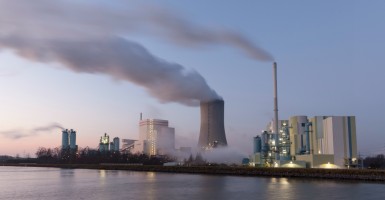President Obama signed Thursday an executive order to require executive agencies to improve energy efficiency and cut greenhouse gas emissions. One has to hope the order will save taxpayers money, because it won’t make a dent in global temperatures.
Headlines have focused on the top line features of the plan, requiring executive branch departments and agencies by the year 2025 to:
- Cut greenhouse gas emissions by 40 percent (from 2008 levels),
- Increase the use of renewable electricity by 30 percent,
- Expand the federal fleet with alternative fuel vehicles and cut greenhouse gas emissions per mile by 30 percent,
- Cut energy use at federal facilities by 2.5 percent, and
- Reduce water demands by 2 percent.
The president got it at least half right when he said “priority should first be placed on reducing energy use and cost, then on finding renewable or alternative solutions.” Insofar as some of these measures save taxpayers money in the long term the president’s direction isn’t necessarily a bad thing.
Obama’s efforts though amount to little more than piggybacking on the direction federal energy use has been headed anyway. The U.S. government is one of the largest energy consumers in the world, according to the Energy Information Administration. However, energy consumption by federal facilities, vehicles and equipment has been falling since 1975 (when data first was collected) and is at its lowest levels yet.
But Obama’s executive order quickly departs from an appropriate use of federal resources and manpower. The clear goal is not to save taxpayer money but to meet the “clear overarching objective of reducing greenhouse gas emissions across Federal operations and the Federal supply chain” through “sustainability goals.”
The order establishes a “clean energy target” for agencies to meet a schedule of targets every two years for energy and electricity consumption of renewable sources. From there it quickly becomes evident that the order’s goals are less about energy efficiency or greenhouse gas emissions and more about propping up certain companies and products. The executive order prioritizes energy supplied from specific types of technology such as carbon capture and sequestration, small modular nuclear reactors, thermal energy, electric and E-85 vehicles, and public transit. When leasing facility space, federal agencies are required to first determine the CO2 emissions or energy consumption of a space and include “climate-resilient design and management elements into the operation, repair, and renovation of” new and existing buildings. Executive agencies are to prefer products and partners labeled as ENERGY STAR, WaterSense certified, Safer Choice, SmartWay Transport, BioPreferred, SNAP chemical, FEMP-designed and “environmentally sustainable electronic products.”
The White House Council on Environmental Quality (CEQ) has been tasked to monitor and guide the overall progress on the program and agencies are to develop, implement and regularly report on their Strategic Sustainability Performance Plans. Staff are also to undergo education and training on “environmental sustainability and climate preparedness.” This is distraction enough of time, manpower, and funds. Furthermore, the order repurposes an old Environmental Protection Agency position to create a senior level position called the Federal Chief Sustainability Officer and supporting staff to assist the new Council in carrying out the targets and reporting.
Had Obama stopped with the priority being reducing energy use and cost, he would have been within the limited and appropriate realm the federal government can play in to make public resources and facilities more energy efficient. Beyond that is a bridge too far to corporate welfare and potentially many expensive or short-sighted decisions that consider politics more than taxpayers, budget common sense and mission priorities.





























